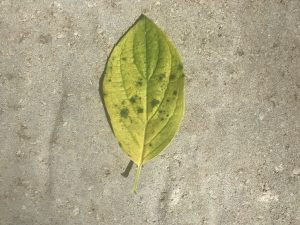Hydrangea Leaves Turning Yellow Fundamentals Explained
Wiki Article
Getting The Hydrangea Leaves Turning Yellow To Work
Table of ContentsThe smart Trick of Hydrangea Leaves Turning Yellow That Nobody is DiscussingThings about Hydrangea Leaves Turning YellowAn Unbiased View of Hydrangea Leaves Turning YellowThe Single Strategy To Use For Hydrangea Leaves Turning YellowHow Hydrangea Leaves Turning Yellow can Save You Time, Stress, and Money.
The container needs to be large enough so the plant can grow and obtain every one of the water and nutrients it needs. Location the container on a patio, or in a shady area on a patio. You can likewise replace the plant with a panicle hydrangea. Panicles like the complete sun.So, no matter the variety, plan ahead and ensure your plant has lots of protection from the wind. You have a few choices below. You can transplant to a brand-new area, or you could produce a wind barrier making use of another plant, or fencing. To produce a wind barrier you could, or a hedge to obstruct the wind.
Ornamental lawn, Rose of Sharon, or Holly bushes are simply a couple of concepts of plants you can utilize to obstruct the wind. If you require to hair transplant, find a spot in your yard that is well safeguarded from sunlight and wind. Hair transplanting is ideal carried out in the fall or the spring.
The plants location is the most vital variable when it comes to getting recognized and appropriate development. With a little forethought on planting area and correct maintenance, you'll be able to ensure your hydrangeas!.
The Main Principles Of Hydrangea Leaves Turning Yellow

You can save the plant from yellow leaves by supplying it the appropriate light and positioning. If your plant gets yellow fallen leaves, relocate it to a dark location.
, and temperature level changes can cause yellowing fallen leaves and brown spots. If it obtains also warm, the sides of the leaves end up being yellow, transform brownish and develop a crunchy appearance.

All about Hydrangea Leaves Turning Yellow
you could try these out However, yellow fallen leaves in Hydrangeas are the first signs of disease infestation, commonly followed by black areas, browning, goes down, and wilting. Isolate the diseased or pest-infested plant from the healthy plants to stop disease spread. If it is a garden plant, remove all the infected leaves making use of sanitized devices and tidy up all the debris.So, cutting off aids Hydrangea color unneeded weight and insurance coverage, allowing the development of brand-new fallen leaves. The ideal time to look at more info prune Hydrangeas is spring when the plant prepares to grow foliage for the next season. Examine for spent or infected fallen leaves and cut the base of a stalk that joins the leaves and stem.
Avoid reducing healthy or environment-friendly fallen leaves, and do not eliminate more than 25% of the plant's vegetation. The primary factor behind the red leaves in Hydrangea is bad soil or ecological conditions.
Repot the plant every year in springtime or every 2 years if the development rate is slow.
Some Of Hydrangea Leaves Turning Yellow
There are 6 primary reasons this might take place:: The plant does not get enough sunlight.: The roots are either also damp or too dry.: The plant is too cold.: The dirt is not acidic or alkaline enough for the hydrangea.: The plant isn't getting the right nutrients it requires to stay healthy and balanced.
Each factor impacts the plant in a way that can be taken care of if we understand just how to care for hydrangeas the best way. When we speak about insufficient light for hydrangeas, we suggest that the plant isn't obtaining enough sunshine.
Without enough sunlight, the fallen leaves can turn yellow, the plant can come to be weak, and it may generate fewer flowers. To ensure directory a hydrangea receives appropriate light, it ought to be positioned in a spot where it can enjoy the early morning light and be protected from the intense mid-day sunlight. Overwatering is when a hydrangea plant gets even more water than it needs.
Yellow fallen leaves may be an indicator that the plant is getting too much water. On the other hand, dehydration occurs when the plant doesn't obtain adequate water.
Hydrangea Leaves Turning Yellow - An Overview
This problem prevails in the fall as the weather changes or if a hydrangea is grown in an area where it doesn't obtain adequate heat from the sun. It's essential to know the right problems for hydrangeas to stay clear of low-temperature anxiety. The majority of hydrangeas grow ideal in areas 6 to 9, where the climate is milder.It is essential to know that this sort of yellowing is various from the yellowing triggered by problems like way too much water or otherwise enough light. If the yellow fallen leaves are primarily at the bottom of the plant and the remainder of the plant looks healthy and balanced, it could simply suggest that the leaves are simply obtaining old.
Report this wiki page